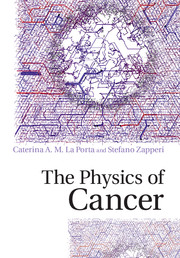Book contents
- Frontmatter
- Dedication
- Contents
- Preface
- 1 Introduction to the Cell
- 2 The Biology of Cancer
- 3 A Modeling Toolbox for Cancer Growth
- 4 Vascular Hydrodynamics and Tumor Angiogenesis
- 5 Cancer Stem Cells and the Population Dynamics of Tumors
- 6 Biomechanics of Cancer
- 7 Cancer Cell Migration
- 8 Chromosome and Chromatin Dynamics in Cancer
- 9 Control of Tumor Growth by the Immune System
- 10 Pharmacological Approaches: Old and New
- 11 Outlook on the Physics of Cancer: A New Interdisciplinary Area
- References
- Index
8 - Chromosome and Chromatin Dynamics in Cancer
Published online by Cambridge University Press: 04 May 2017
- Frontmatter
- Dedication
- Contents
- Preface
- 1 Introduction to the Cell
- 2 The Biology of Cancer
- 3 A Modeling Toolbox for Cancer Growth
- 4 Vascular Hydrodynamics and Tumor Angiogenesis
- 5 Cancer Stem Cells and the Population Dynamics of Tumors
- 6 Biomechanics of Cancer
- 7 Cancer Cell Migration
- 8 Chromosome and Chromatin Dynamics in Cancer
- 9 Control of Tumor Growth by the Immune System
- 10 Pharmacological Approaches: Old and New
- 11 Outlook on the Physics of Cancer: A New Interdisciplinary Area
- References
- Index
Summary
Cancer typically displays alterations in the number of chromosomes, often the result of incorrect segregation during cell division, as we discuss in Section 8.1. Faithful chromosome segregation relies on the combined action of motor proteins and microtubules which must first align all the chromosomes on the cell central plate. This complex process can be described realistically by computational models which allow the effect of several biological factors on cell division to be tested, as we discuss in Section 8.2. In addition to chromosomal alterations, cancer cells often display other defects in nuclear architecture and chromatin organization, as we review in Section 8.3.
Chromosomal Instability
As discussed previously, cancer results from the accumulation of genetic mutations, but how these mutations are generated is debated. A high frequency of mutations, known as genetic instability, is believed to be a key property, if not a requirement, of most tumors (Lengauer et al., 1998). Genetic instability exists at the level of the nucleotides, resulting from their insertions, delations or substitutions, or at the level of the entire chromosome. Indeed, most cancers display an altered number of chromosomes, a state known as aneuploidy, and mis-segregated chromosomes at high rates, a condition known as chromosomal instability (CIN) (see Figure 8.1). Aneuploidy is simply detected by counting chromosome numbers, a task that can easily be achieved by several experimental techniques (Thompson et al., 2010). Detection of CIN requires instead the measurement of chromosome mis-segregation rates, which involves counting the number of chromosomes at different times in clonal populations.
CIN is a characteristic feature of human solid tumors and of many hematological malignancies (Boveri, 1903), a principal contributor to genetic heterogeneity in cancer (Burrell et al., 2013a) and an important determinant of clinical prognosis and therapeutic resistance (Lee et al., 2011; Bakhoum and Compton, 2012). While the link between aneuploidy and cancer was recognized already over a century ago (Boveri, 1903), general understanding of the mechanisms leading to CIN, as well as appreciation of its consequences on cellular viability and tumor evolution, has grown considerably over the past two decades (Bakhoum and Compton, 2012; Thompson et al., 2010).
- Type
- Chapter
- Information
- The Physics of Cancer , pp. 112 - 122Publisher: Cambridge University PressPrint publication year: 2017

